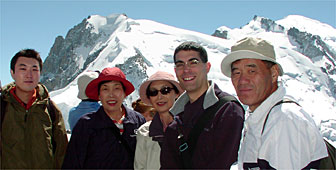Alp hopping with the Japanese

How do you keep a group of Japanese tourists in Switzerland for as long as possible? The answer, according to Swiss tourism officials, is to send them up a mountain.
“I try to send them up at least one mountain,” says Andreas Wieland, director of Switzerland Tourism Asia.
“If they go up to Jungfrau or to Zermatt to take the cable car to Klein Matterhorn, it takes some time until they come back down, they are tired, and so they have to stay another night in Switzerland,” he adds.
The unusual tactics to encourage Japanese to stay more than just 24 hours in the country are part of a new initiative to make Switzerland a destination in its own right, rather than just a stop for groups on an extended European tour.
But on an August evening in the mountain resort of Zermatt, it hardly seems necessary to force the Japanese to stay in the country.
Up to 50 per cent Japanese
Wieland estimates that between 40 and 50 per cent of the high season visitors to the resort are Japanese, and a walk up the main thoroughfare from the station to the central square is enough to confirm the statistics.
Young Japanese couples walk through the village in search of the perfect location from which to photograph themselves in front of the Matterhorn at sunset, while larger groups are shepherded from station to hotel in time for their evening meal.
But what attracts the people of an island nation on the other side of the world to a land-locked country in the centre of Europe?
Statistics published by Switzerland Tourism indicate that just over one million overnight stays in Swiss hotels were booked last year by the Japanese, while the number of repeat visitors has risen steadily over the last decade.
Whistle-stop mountain tour
To discover a little more about the reasons behind the Japanese love affair with Switzerland, I arranged to follow a party of ten Japanese (plus guide) on a 12-hour, whistle-stop tour which would take us from the Matterhorn to Mont Blanc before descending on the city of Lausanne in time for dinner.
At precisely 7am, Sachiko Chiba, the tour group’s irrepressibly enthusiastic guide, leads us towards the Klein Matterhorn cable car for the first ascent of the day to an observation point at 3,820 metres above sea level.
Chiba provides everyone with a boiled sweet (included in the seven-day package tour price of SFr3,500) to cope with the sudden change in altitude, but this does not prevent some anxious faces as a sudden gust of wind temporarily transforms the gentle cable car ascent into a white-knuckle ride.
Stepping gratefully off the cable car at the summit, Katsuko Nishimura explains that it is Switzerland’s mountain scenery that brought her here.
“It’s been the dream of my husband and I to visit Switzerland for years,” she says.
“Now we’ve finally made it and the mountains are even more impressive than we imagined them to be.”
Fifteen minutes later, with just enough time to wind on a roll of film, the group descends back towards Zermatt to begin the next part of the journey.
Next stop: the resort of Chamonix, just over the Swiss border in France, where another cable car awaits to whisk the group up to the 3,842m Aiguilles du Midi summit, celebrated for its view of snow-capped Mont Blanc.
While admiring the view of Mont Blanc glistening in the distance, Takeshi Kuroha takes the opportunity to reflect on his impression of the country we have temporarily left behind.
“My overriding impression of Switzerland is not so much of particular sights, but of the country as a whole,” Kuroha says.
Back on the bus
“Unlike in Japan, for instance, there seems to be an emphasis on protecting the environment for the future and not just enjoying it in the present. Also, we Japanese are very insular in the way we look at the outside world, so I think we can learn something from the way Switzerland communicates with other countries.”
Picking up the coach again which now heads towards Lausanne, newlywed Natsue Enomoto says her fascination with Switzerland stems from a childhood in Tokyo spent watching “Heidi” on television.
“The programme gave an impression of energy and vitality about Switzerland,” Enomoto says.
“Now I’m here, I see a country blessed by nature with abundant mountains and rivers – even more so than in the images on television. The only thing that is different is that in ‘Heidi’ everyone went about in horse and cart, whereas what you really see is cars everywhere.”
During the last stage of the descent from the mountains, all members of the group speak with great affection about the country they have seen close-up, and many say they will return in the future as one of the growing number of independent Japanese travellers to Switzerland.
As the coach finally pulls into the city of Lausanne, Chiba reminds the group just how much has been accomplished in a single day: Two countries, two mountains and a change in altitude of several thousand metres – twice.
The 12-hour day has left little time for souvenir shopping, which is perhaps just as well. As Natsue Enomoto explains, the souvenir she would like to buy is not for sale.
“The one thing I would dearly love to take back with me is a couple of bottles of fresh Swiss air – something we badly need in Japan.”
by Ramsey Zarifeh

In compliance with the JTI standards
More: SWI swissinfo.ch certified by the Journalism Trust Initiative
You can find an overview of ongoing debates with our journalists here . Please join us!
If you want to start a conversation about a topic raised in this article or want to report factual errors, email us at english@swissinfo.ch.